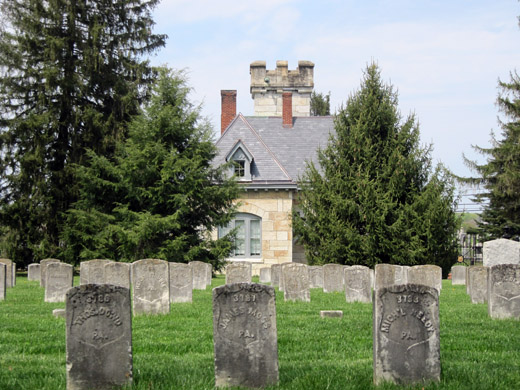Mark Twain wasn’t joking when he griped that Southerners’ obsession with the chivalric novels of Sir Walter Scott helped cause the Civil War. In Life on the Mississippi, he laments that Scott had “run the people mad, a couple generations ago, with his medieval romances,” inspiring “maudlin Middle-Age romanticism here in the midst of the plainest and sturdiest and infinitely greatest and worthiest of all the centuries the world had seen”:
The South has not yet recovered from the debilitating influence of his books. Admiration of his fantastic heroes and their grotesque “chivalry” doings and romantic juvenilities still survives here, in an atmosphere in which is already perceptible the wholesome and practical nineteenth-century smell of cotton-factories and locomotives; and traces of its inflated language and other windy humbuggeries survive along with it.
I kept Twain in mind last week when I visited Antietam National Battlefield, the site of the single bloodiest day in American history: September 17, 1862, when Union and Confederate armies clashed, taking 23,000 casualties between them. The rangers at Antietam give thorough and informative talks, and I visited some of the famous sites with all due solemnity—but then I stumbled onto medievalism in the cemetery just to the south.
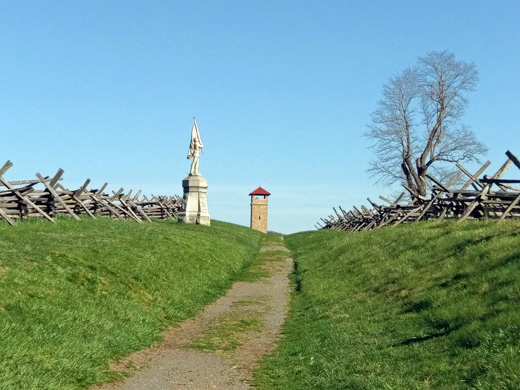
According to architectural historian Catherine Zipf, the job of designing and beautifying Civil War cemeteries fell to Montgomery Meigs, Quartermaster General of the U.S. Army during and after the war. Every cemetery was to have a superintendent’s lodge, and Meigs standardized the design: each lodge was located near the gate or the edge of the cemetery, shaped like an L with a porch and reception hall, and built in a scaled-down French Second Empire style. Here’s a good example from Glendale National Cemetery in Richmond, Virginia:
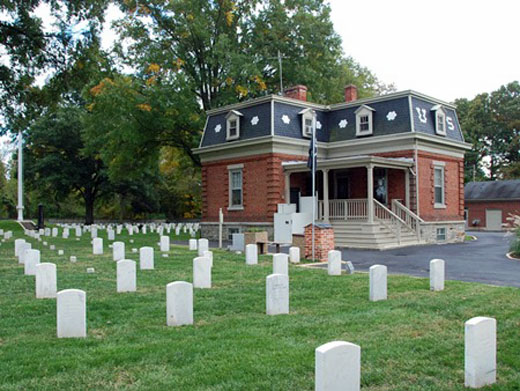
(Glendale National Cemetery, Richmond; photo from the U.S. Department of Veterans Affairs website)
After 1865, the Second Empire style was popular for federal architecture, most notably in the then-new State, War, and Navy Building next to the White House. Zipf argues that the style screamed modernity and federal control, especially when the government dropped these lodges into Southern cemeteries, where they contrasted starkly with the Greek-revival porticoes of big plantation houses. The Confederate dead were usually excluded from these cemeteries, and the huge “U.S.” on the second stories of the lodges was not subtle. Meigs let no questions linger about which side had won, and what that meant for the conquered.
So then why does the lodge at Antietam look like this?
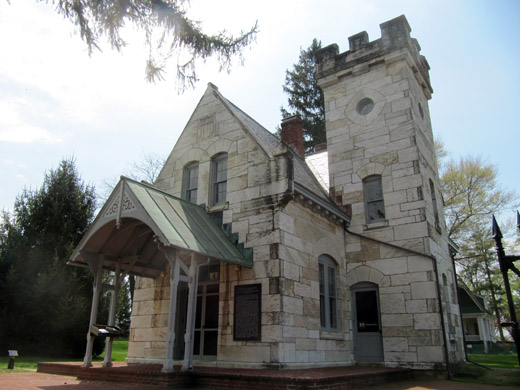
What an odd, dreamlike blending of castle and house. According to a memo on this lodge by the National Park Service’s Historic American Buildings Survey, the federal government ran 80 national cemeteries by 1880, but Antietam was one of only two originally established and run by a state. Maryland got the jump on things by convening its own cemetery commission, sending the Confederate dead to be buried elsewhere, and hiring versatile D.C.-based architect Paul Pelz to design and build this lodge in 1867. The Park Service helpfully points out its distinctive features: “stone walls, turret tower with battlements, pointed arch windows, and a gable porch with crossbracing vergeboards.” (The latter term was new to me.) The tower gave veterans and visiting mourners a view of the battlefield, but this little castle didn’t earn fealty from locals. According to the Park Service, ne’er-do-wells loitered in the cemetery, incurring the wrath of superintendents who demanded that they stop using the grounds (in the words of an 1881 War Department inspector) “as a lounging place for the floating part of the citizens, canal men, loafers, young fellows and their sweethearts.”
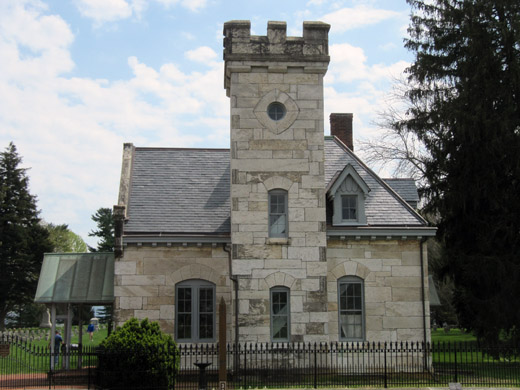
So why is the lodge at Antietam so unlike its counterparts in other federal cemeteries? American medievalism surged in the 1870s. Tourism to Europe had never been higher; at Harvard, Henry Adams became the country’s first professor of medieval history; other campuses would soon start hiring medievalists and building in neo-medieval styles; and New Yorkers were drawing up plans for the Cathedral of St. John the Divine. I suppose it’s possible that the Maryland cemetery commission chose a versatile architect simply because they wanted a trendy building.
Yet I think something bigger is going on here. Maybe this little castle reflects Maryland’s ambivalence as a slave state that stayed in the Union, neither northern nor southern in its economic mainstays or social sympathies. That’s one way to explain why a cemetery that excludes the Confederate dead would evoke the chivalry that drove wealthy Southerners to war. Maybe some Marylanders hoped to pry medievalism out of Southern hands by claiming the symbolism as a spoil of war, quashing its power by making it fully American. Maybe the house-and-tower design says that domestic tranquility is buttressed by military defense. All those things may be so—but the most likely explanation is that the lodge at Antietam is a reaction to horror, a fearful attempt to push the bloodiest day in American history—in 1867, still a fresh wound—back into a romanticized past, making it romantic, heroic, less awful to face.
If that’s the case, then the builders deceived themselves. The first federal superintendent, Civil War veteran George A. Haverfield, assumed his post here in 1879, but a War Department letter unearthed by the Park Service suggests that an unorthodox but presumably generous gesture brought down swift violence upon the house:
Haverfield, having no family with him, had his laborer and the laborer’s wife live in the lodge, and boarded with him. The husband got jealous of the Superintendent, and rather, reversing the usual order in such cases, the husband was shot dead by the accused wife. It was through this sad occurrence that I learned that Haverfield was not living with his family. Had he been, the tragedy would probably not have happened.
(letter from Captain A.F. Rockwell to Quartermaster General, 20 August 1879, cited in the Historic American Buildings Survey report on the lodge)
A graveyard castle, a love triangle, jealousy, murder—the story has all the makings of a lurid Gothic novel, and the longtime closure of the tower gives the lodge a further tinge of mystery. Twain, of course, would have shaken his head. If the architects of the Antietam lodge thought they could romanticize the battlefield, softening the carnage through the heroic haze of knightly combat, then they misunderstood the limits of medievalism. You can’t plaster over the horrors of war; the blood finds a way to seep out in the end.
